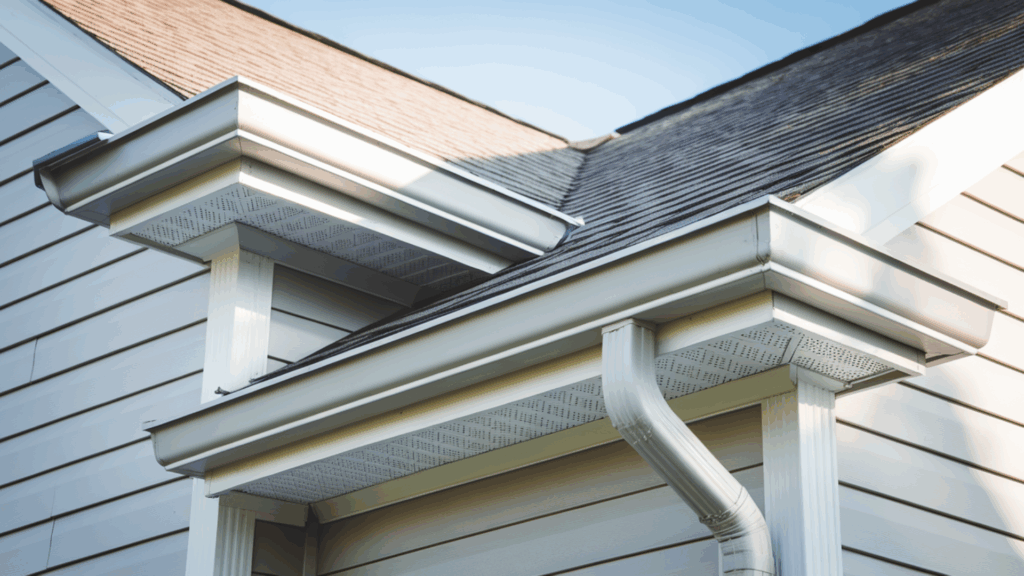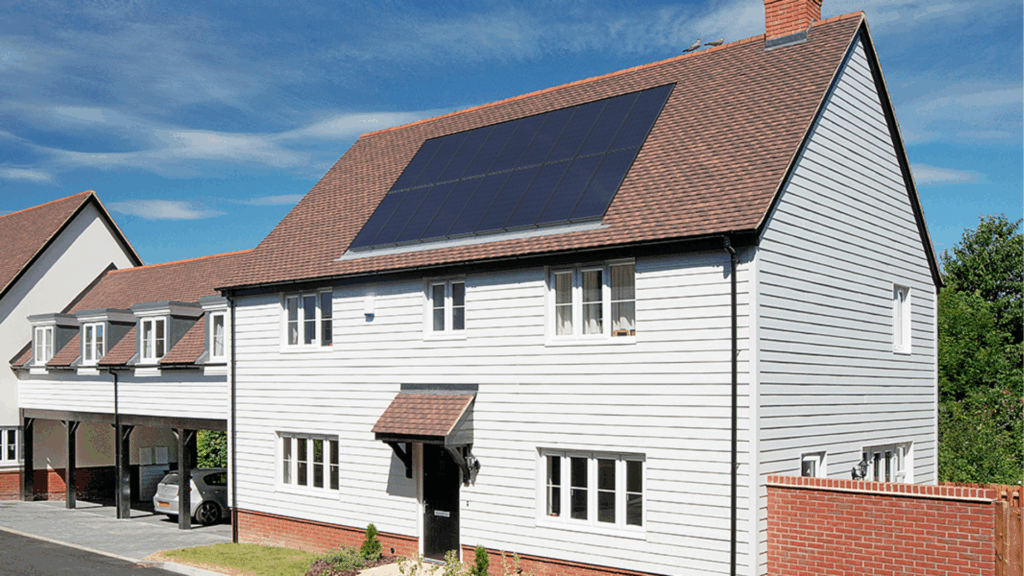I used to think roof eaves were just there to complete the roofline, a lovely little trim, something that added character but didn’t do anything.
That all changed after I saw what happened to my neighbor’s home. They skipped the eaves to save a few dollars during construction.
A few months in, water started pouring straight off the roof onto their siding. Before long, the window trim warped, paint peeled, and water pooled around the base of the house. Eventually, the damage reached the foundation.
Watching that unfold made me pay more attention to my own home and to what eaves do. Turns out, roof eaves aren’t just decorative.
They manage moisture, block harsh sun, help with attic airflow, and even improve your home’s energy efficiency. In this blog, I’ll walk you through what roof eaves are, why they matter, and how they can protect your home for years to come.
What Are Roof Eaves?

Roof eaves are the edges of your roof that extend beyond the walls of your house. That overhang, whether it’s just a few inches or a few feet, is more than just for looks.
Eaves protect the siding and foundation by channeling rainwater away from your home. They also play a role in how sunlight, wind, and snow interact with your house.
Core Components of Eaves
Each part of the eaves serves a specific function:
- Soffit: The underside of the eave. It’s usually vented to allow air into your attic.
- Fascia: The vertical board that caps the edge of the roof and holds the gutters.
- Rafter Tails: The exposed ends of the roof’s structural beams form the backbone of the overhang.
Together, these parts form a system that supports ventilation, weather protection, and design.
Different Types of Roof Eaves
Roof eaves come in different styles that impact both function and appearance. The most common types are open, boxed, and closed eaves, each offering unique benefits in ventilation, protection, and design appeal.
Open Eaves
Open eaves expose the rafter tails beneath the roof overhang, creating a visible and decorative effect.
Common in craftsman and rustic-style homes, they offer easier inspection and ventilation but may require more upkeep to protect the exposed wood.
Boxed Eaves
Boxed eaves are fully enclosed, hiding the rafters with soffit and fascia panels for a clean, finished look.
They offer excellent protection against pests and weather and are commonly seen in modern and traditional homes due to their low-maintenance appeal.
Closed Eaves
Closed eaves are enclosed, similar to boxed eaves, but with a simpler, more streamlined design and minimal detailing.
Often used in contemporary or minimalist homes, they provide adequate protection while maintaining a clean, understated appearance.
Comparison Table of Different Eaves
| Type of Eave | Description | Common Styles | Benefits | Maintenance |
|---|---|---|---|---|
| Open Eaves | Exposes the rafter tails beneath the roof overhang for a visible and decorative effect. | Craftsman, Rustic | Easier inspection and ventilation add visual charm. | Requires more upkeep to protect exposed wood. |
| Boxed Eaves | Fully enclosed with soffit and fascia panels, hiding the rafters for a clean, finished look. | Modern, Traditional | It provides excellent protection against pests and weather and has low maintenance. | Minimal maintenance. |
| Closed Eaves | Enclosed like boxed eaves but with a simpler, more streamlined design and minimal detailing. | Contemporary, Minimalist | It provides adequate protection while maintaining a clean, simple look. | Low maintenance. |
Functional Benefits of Roof Eaves
Roof eaves do more than complete the look of your home; they play a key role in keeping it dry, calm, and structurally sound.
From managing rainwater runoff to reducing heat gain and supporting attic ventilation, eaves offer essential protection and energy-saving benefits year-round.
1. Rainwater Management
One of the primary roles of roof eaves is to guide rainwater away from your home.
When rain falls, eaves extend the roofline, allowing water to drip farther from the siding and foundation, thereby reducing splashback and preventing erosion.
Combined with a gutter system, they help avoid leaks, mold, and long-term structural damage near the base of the house.
2. Sunlight and Heat Reduction
Eaves act as natural sunshades by blocking harsh sunlight from hitting windows and upper walls.
This is especially important in hot climates, where excess sun exposure can make indoor spaces uncomfortably warm.
By reducing direct heat gain, eaves help your cooling system work more efficiently and can lead to noticeable energy savings over time.
3. Snow and Ice Control
In snowy regions, roof eaves play a crucial role in managing melting snow and runoff. As snow melts, eaves provide gutters with space to collect and redirect water properly.
Without them, ice dams can form at the roof edge, forcing water back under the shingles and causing leaks or damage to the roof deck. Proper eaves reduce this risk significantly.
4. Ventilation Support
Soffit vents installed beneath the eaves allow fresh, cool air to enter the attic. This air rises and exits through ridge or gable vents, creating a continuous flow.
Good ventilation helps regulate attic temperature, keeps insulation dry, and prevents moisture buildup that could otherwise lead to mold, mildew, and wood rot inside your roof structure.
5. Structural Longevity
Eaves serve as a first line of defense for your home’s exterior surfaces. By keeping rain, snow, and harsh sun off walls, fascia, and window trim, they minimize weather-related wear and tear.
Over time, this protection adds years to the life of your roofing materials and siding while also preserving the overall condition and appearance of your home.
Understanding Eaves and Attic Ventilation
Eaves help your attic breathe by allowing fresh air to enter through soffit vents. This airflow reduces heat buildup in summer and moisture in winter, which helps prevent mold, wood rot, and roof damage over time.
- The Role of Soffit Vents: These draw in cooler outdoor air, which then rises and exits through ridge or gable vents. This constant airflow prevents heat buildup in summer and moisture accumulation in winter.
- Moisture Control and Mold Prevention: Warm, moist air trapped in your attic can lead to condensation, which damages wood framing. Eaves with soffit vents help keep that air moving, protecting your roof from the inside out.
Roof Eaves: Energy Efficiency and Cost Savings
Roof eaves improve energy efficiency by shading upper windows and reducing indoor heat gain.
They also support proper attic ventilation, which keeps insulation dry and effective, thereby lowering cooling costs in the summer and helping to maintain steady indoor temperatures year-round.
- Lower Cooling Cost: Eaves shade the upper windows, cutting down on direct sunlight and reducing the strain on my AC.
- Insulation Support: Insulation only works well when it stays dry. Eaves help keep moisture out and allow airflow to pass over the insulation, keeping it effective throughout the year.
Problems Caused by Missing or Damaged Eaves
Without properly functioning eaves, rainwater runs directly down exterior walls, which can lead to siding damage, foundation issues, and mold growth.
1. Water Damage to Siding and Foundation
Without eaves, rainwater runs directly off the roof and down the walls, soaking siding and pooling near the foundation.
Over time, this can lead to peeling paint, wood rot, and even cracks or settling in the foundation, issues that are costly to repair and often preventable with proper eaves.
2. Increased Risk of Mold and Mildew
Missing or damaged eaves allow excess moisture to enter your home’s exterior layers and attic.
This creates an ideal environment for mold and mildew growth, which can spread quickly and compromise indoor air quality, insulation performance, and the structural integrity of your home.
3. Higher Energy Bills and Poor Indoor Comfort
Without the shade and airflow that eaves provide, homes heat up faster in the summer and retain damp air in the winter.
This leads to more frequent use of heating and cooling systems, driving up energy costs and making it harder to maintain a stable, comfortable indoor climate.
4. Faster Roof Deterioration
Eaves also support attic ventilation when they’re missing or blocked, heat and moisture build up under the roof deck, causing shingles to age prematurely.
This can shorten the lifespan of your roofing system and increase the likelihood of costly repairs or early replacement.
5. Pest Intrusion and Structural Weakness
Gaps in soffits or rotted fascia boards can invite birds, squirrels, and insects to nest inside your roof.
Once pests enter, they can damage insulation, wiring, and wood structures, creating bigger problems that extend beyond just the eaves.
Maintenance Tips for Long-Lasting Roof Eaves
Regular maintenance keeps your eaves in top shape. Inspect for signs of rot, peeling paint, or water stains, and clean gutters to prevent overflow.
- Inspect for Rot, Stains, and Leaks Regularly: At least twice a year, walk around your home and examine the eaves closely. Look for signs of softwood, peeling paint, sagging sections, or water stains.
- Clean Gutters and Downspouts Frequently: Clogged gutters are one of the biggest threats to your eaves. When water can’t drain properly, it overflows and soaks the fascia and soffits, leading to rot.
- Repaint or Reseal Wooden Eaves: If your soffits and fascia boards are made of wood, apply a fresh coat of paint or sealant every few years. This protects the surface from UV rays, rain, and temperature changes.
- Check for Vent Blockages: Soffit vents are essential for attic airflow, but they can get clogged with debris, dust, or nesting materials. Use a flashlight or blower to ensure vents remain open and clean.
- Tighten or Replace Loose Hardware: Over time, nails or screws holding the fascia or soffit panels can loosen due to wind or vibration. Periodically check that all components are securely attached.
Conclusion
It’s easy to overlook something as simple as roof eaves. They’re not flashy, and most people don’t even think about them until something goes wrong.
But as I learned, watching my neighbor’s home take on water damage, skipping eaves, or letting them deteriorate can cost you far more than you expect.
Eaves do more than finish off your roof; they control water, block heat, ventilate your attic, and help your home look balanced and beautiful.
In climates with intense sun, snow, or rain, they’re a quiet but critical defense against the elements.
If you’re building new or planning a renovation, don’t let this small feature fall through the cracks. Pay attention to your roof eaves. Give them the materials, design, and maintenance they deserve.
Your siding, attic, foundation, and even your wallet will thank you in the long run.

